Brother, Can You Spare a Lime?
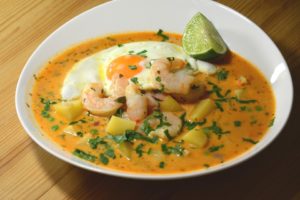
Peruvian Chupe de Camarones with lime wedge.
“In my country, we don’t like the yellow one.” My Thai hairdresser and I were talking about the merits of limes and lemons at a Dupont Circle salon. At Santa Rosa, the late Peruvian seafood restaurant in Adams-Morgan, I asked my waitress about the lime wedge that accompanied my chupe de camarones, a reddish-orange shrimp chowder filled with rice, potatoes, egg, and a small ear of corn. I should squeeze the “limon” in the soup, she said. You mean lime, I responded. She looked baffled. Instead of words, we talked colors. The “green” one, she told me, was better than the “yellow” because the fruit was more sour. Sometime later in a Latin grocery, I passed a display of limes with a sign that said “limas.” Another Hispanic shop advertised limones verdes (green lemons).
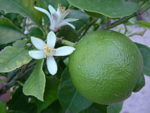
A lime bush in blossom.
The saga of the lime is a tale of puzzles. The most delicate member of the citrus family, the thin-skinned fruit can easily perish outside a tropical climate. Its cousin, the lemon, is more resilient. The lime tree, a shrubby evergreen with spiny twigs, grows small white flowers. Fragrant oils flow through sacs in its leaves and outer rind.
Native to India and Malaysia, the lime was treasured as much for its spiritual power as for its flavor. In Malaysia, botanist I.H. Burkill points out, limes were given to elephants to make them “sagacious.” Brahmin widows in India, Piero della Valle, a 17th century Italian writer reports, were required to ride once a day around the city, face uncovered, holding a lime in one hand and a mirror in the other.
The Arabs, the preeminent early traders and transplanters of citrus, called the yellow fruit they discovered in India a “laimun.” They often used the same word for lime. When Islamic writers tried to describe the novel fruit, they fell back on familiar language. Abd el-Latif, a 13th century writer, marveled at a “balm lemon of smooth skin the size of a pigeon’s egg.”
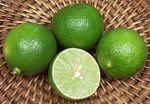
Key limes in a basket
The Arabs brought citrus fruits from India to Arabia in the 9th century. As they expanded into Spain, the Middle East, and Africa, they introduced the fruits to their colonies. The Moors in Spain decorated their towns with tableaus of citrus. “[M]ost of the houses of Seville, not to say all, were abundantly provided with running waters, and spacious courts planted with fruit trees such as the orange, the lemon, the lime,” wrote Ismail Ibe Mohammed al-Shakandi, an Arabic geographer.
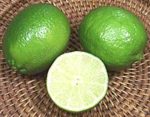
Persian limes in a basket
The rulers, who infused their own food with a citric fragrance, introduced their methods to their subjects. From the Arabs, the Spanish learned the technique of marinating meats with sour orange and other “acid fruits.”
The lime arrived in the New World with the Spanish and the Portuguese. In the 16th century, it was taking hold in the West Indies, Central America, and Mexico, which is today the world’s largest producer of the fruit. The formal name for the fruit in Spanish is lima, but people commonly used limon to refer to both lemons and limes.
By the early 19th century, limes were growing in backyards and wild in thickets in South Florida. After a hurricane in 1906 killed the pineapple crop in the Florida Keys, growers started farming limes commercially. They planted the key lime, the “true lime” as it was called. It was the same fruit as the Mexican and West Indian lime, all of which descended from the original Malaysian and Indian species.
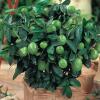
Key lime bush.
The golf-ball sized fruit comes from a thorny plant, which adapted well to the Florida heat and dry climate. Lest we romanticize them, they are born on “scruffy, homely little trees,” as New York Times writer R.W. “Johnny” Apple described them. “They actually flourish in adversity,” horticulturalist Larry M. Schokman told the journalist. “They fruit even in chalky or rocky soil, with little irrigation and fertilization.”
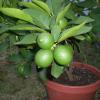
Persian lime growing in pot
More hurricanes ended lime cultivation in the Keys in 1926. Commercial farmers replaced the key with the Persian lime, a hybrid. Unlike the key, it had seeds and was twice its size. Although the Persian lacked the exquisitely sour taste of its rival, the fruit was highly marketable, argues food historian Raymond Sokolov in his book, Fading Feast. “The Key lime could not hold its own against leather-skinned, easy-to-ship, hardier, seedless, larger but far less delicious . . . limes.” Moreover, the thorn-free plants were easier to handle. The limes of the Persian group, which are sold green rather than a ripe yellow, dominate the supermarket shelves today.
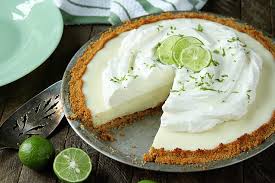
Key lime pie
Despite the devastation to the crop, the fruit was beloved by the people of the Keys and by the tourists who thronged there for key lime milkshakes and key lime saltwater taffy. The popularity of the fruit in the U.S. soared with the advent of key lime pie. Likely dreamed up in the 1890s, the treat made its way into culinary Americana. New York Times food critic Craig Claiborne hailed it as “the greatest of all American regional desserts.” For the ecstatic author of a 1936 recipe, the pie was a “Conch contribution worthy of the Cordon Bleu.”
The story of key lime pie is steeped in folklore. Its creation, many experts suggest, is bound up with the availability of canned sweetened condensed milk, an ingredient central to the dessert. Invented by Gail Borden in 1856, the product was a godsend in the Keys, where no fresh milk was sold until the 1930s.
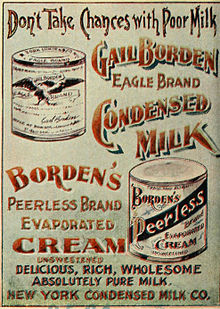
Ad for Borden’s sweetened condensed milk
Millionaire businessman William Curry transported cases of condensed milk to the Keys in the 1850s. The milk, key lime authority David L. Sloan explained to food writer, Molly O’Neill, was a boon to residents: “When William Curry brought in cases of condensed milk in the late 1850s, it was a luxury product. He couldn’t stock enough of it. Ships carried it; fishermen carried it. It allowed cooks in the mansions to make cream sauces and ice cream. Canned milk was the precursor to fresh dairy around here. You can do a lot to personalize a pie and let it tell your story, but don’t you even think of using real cream. Sweetened condensed milk is the only way you can get a smooth, creamy filling.”
Condensed milk was a staple on fishing boats: “I’ll go with my theory . . . that says spongers in the 1890s stuck out on the water who were tired of eating fish came up with a treat—lime juice, sweetened condensed milk, bird eggs and old bread,” local historian Tom Hambright told writer Gwen Filosa.

An inviting slice of Key lime pie
Although the pie is frequently not made with key lime, its fans remain enthusiastic. Like the lime itself, the dessert conjures up dreams of tropical delight and the songs of Jimmy Buffett. Even as the fruit has become less plentiful and more expensive, it has retained its mystique. Sophisticated chefs use it for culinary creations like key lime buerre blanc and key lime vinaigrette. High-end grocers sell bags of the fruit as a specialty item.
Some commentators, however, scoff at the key lime mania. “I hate key lime pie,” Stella Parker acknowledges in Serious Eats, the online journal. “They’re tiny, harsh, and abrasive, and a freaking pain to juice. . . . Should you be fool enough to bake a key lime pie without ’em, prepare to be eviscerated by the authenticity police.” Key lime devotees are not likely to be swayed.







